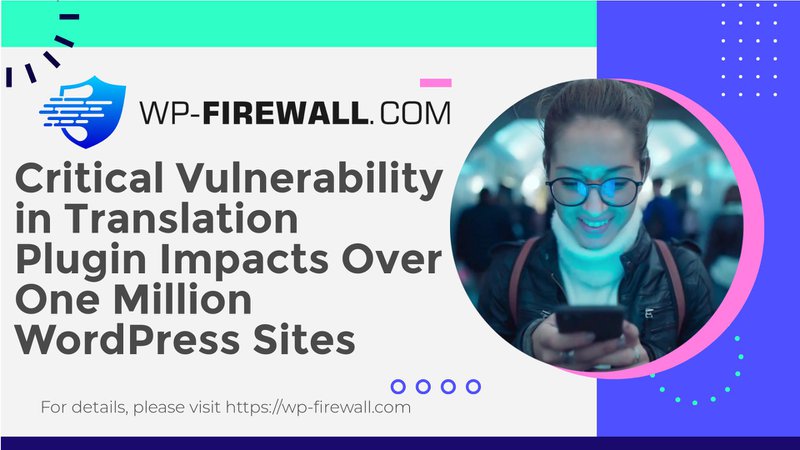
Inzicht in de kwetsbaarheid van de recente WordPress-vertaalplug-in: een beveiligingsperspectief
Invoering
Het WordPress-ecosysteem is enorm en dynamisch, met miljoenen websites die afhankelijk zijn van verschillende plugins om de functionaliteit en gebruikerservaring te verbeteren. Deze afhankelijkheid van plugins van derden kan sites echter blootstellen aan kwetsbaarheden, zoals blijkt uit een recent rapport over een significante beveiligingsfout in een populaire WordPress-vertaalplugin die meer dan een miljoen sites treft. In dit artikel duiken we in de details van deze kwetsbaarheid, de implicaties voor websitebeveiliging en hoe u uw WordPress-site kunt beschermen tegen soortgelijke bedreigingen.
De kwetsbaarheid onthuld
Volgens het rapport van Search Engine Journal is de kwetsbaarheid in kwestie afkomstig van een veelgebruikte vertaalplugin waarmee website-eigenaren meertalige content kunnen aanbieden. De fout werd geïdentificeerd als een potentiële remote code execution (RCE)-kwetsbaarheid, wat betekent dat aanvallers deze kunnen misbruiken om willekeurige code uit te voeren op de getroffen sites. Dit type kwetsbaarheid is met name zorgwekkend omdat het kan leiden tot volledige sitecompromissen, datalekken en ongeautoriseerde toegang tot gevoelige informatie.
Wat is externe code-uitvoering?
Remote Code Execution is een type beveiligingskwetsbaarheid waarmee een aanvaller kwaadaardige code op een doelsysteem kan uitvoeren vanaf een externe locatie. Dit kan leiden tot verschillende kwaadaardige activiteiten, waaronder:
- Gegevensdiefstal: Toegang krijgen tot en diefstal van gevoelige gebruikersgegevens, zoals persoonlijke informatie en betalingsgegevens.
- Site-verminking: Het wijzigen van het uiterlijk of de inhoud van de website om bezoekers te misleiden of schadelijke activiteiten te promoten.
- Distributie van malware: De gecompromitteerde site gebruiken om malware te verspreiden naar nietsvermoedende bezoekers.
Implicaties voor WordPress-gebruikers
De ontdekking van een dergelijke kwetsbaarheid in een veelgebruikte plugin dient als een harde herinnering aan de potentiële risico's die gepaard gaan met software van derden. Voor WordPress-gebruikers benadrukt dit incident verschillende kritische overwegingen:
1. Het belang van regelmatige updates
Een van de meest effectieve manieren om het risico op kwetsbaarheden te beperken, is ervoor te zorgen dat alle plugins, thema's en de WordPress-kern regelmatig worden bijgewerkt. Ontwikkelaars brengen regelmatig updates uit om beveiligingslekken te patchen en als u deze updates niet toepast, kan uw site worden blootgesteld aan bekende bedreigingen.
2. Plugins verstandig kiezen
Niet alle plugins zijn gelijk. Houd bij het selecteren van plugins voor uw WordPress-site rekening met het volgende:
- Reputatie: Zoek naar plugins met positieve beoordelingen en een goede reputatie binnen de WordPress-community.
- Actieve ontwikkeling: Kies plug-ins die actief worden onderhouden en bijgewerkt door hun ontwikkelaars.
- Beveiligingsaudits: Denk aan plug-ins die een beveiligingsaudit hebben ondergaan of waarvan in het verleden direct kwetsbaarheden zijn gemeld.
3. Implementeren van best practices voor beveiliging
Naast het up-to-date houden van plug-ins, moeten website-eigenaren een uitgebreide beveiligingsstrategie hanteren die het volgende omvat:
- Regelmatige back-ups: Maak regelmatig een back-up van uw website, zodat u deze in geval van een inbreuk snel kunt herstellen.
- Gebruikerstoegangscontrole: Beperk de toegang van gebruikers tot alleen degenen die deze nodig hebben en controleer regelmatig de gebruikersmachtigingen.
- Sterke wachtwoorden en tweefactorauthenticatie: Zorg voor een sterk wachtwoordbeleid en overweeg om tweefactorauthenticatie te implementeren voor extra beveiliging.
De rol van webapplicatiefirewalls (WAF)
Een Web Application Firewall (WAF) kan een onschatbaar hulpmiddel zijn bij het beschermen van uw WordPress-site tegen kwetsbaarheden zoals die besproken. Een WAF fungeert als een schild tussen uw website en potentiële bedreigingen, en filtert kwaadaardig verkeer eruit voordat het uw site bereikt.
Voordelen van het gebruik van een WAF
- Realtime detectie van bedreigingen: Een WAF kan verdachte activiteiten in realtime identificeren en blokkeren, waardoor aanvallen worden voorkomen voordat ze schade kunnen aanrichten.
- Bescherming tegen de top 10 kwetsbaarheden van OWASP: Een robuuste WAF is ontworpen om de meest voorkomende kwetsbaarheden van webapplicaties te beperken die door OWASP zijn beschreven, waaronder SQL-injectie, cross-site scripting (XSS) en meer.
- Verminderde serverbelasting: Door schadelijke verzoeken te filteren, kan een WAF de prestaties van uw website verbeteren en de serverbelasting verminderen.
Casestudy: De impact van de kwetsbaarheid
Om de echte implicaties van dergelijke kwetsbaarheden te begrijpen, moet u een hypothetisch scenario overwegen met een kleine e-commercesite die de getroffen vertaalplugin gebruikt. Toen de eigenaar van de site de kwetsbaarheid ontdekte, verzuimde hij de plugin te updaten, wat leidde tot een succesvolle aanval door een kwaadwillende actor.
Gevolgen van de aanval
- Datalek: De aanvaller kreeg toegang tot klantgegevens, waaronder namen, adressen en betalingsgegevens.
- Reputatieschade: Klanten verloren het vertrouwen in de site, wat leidde tot een daling van de verkoop en negatieve beoordelingen.
- Financieel verlies: De eigenaar van de locatie kreeg te maken met mogelijke juridische gevolgen en kosten in verband met de sanering en het herstel.
Dit scenario onderstreept het belang van proactieve beveiligingsmaatregelen en de noodzaak voor website-eigenaren om op de hoogte te blijven van mogelijke bedreigingen.
Hoe u uw WordPress-site kunt beschermen
1. Blijf op de hoogte
Controleer regelmatig beveiligingsnieuws en updates met betrekking tot WordPress-plugins en -thema's. Abonneer u op beveiligingsnieuwsbrieven en volg gerenommeerde bronnen om op de hoogte te blijven van de nieuwste kwetsbaarheden en best practices.
2. Regelmatig beveiligingsaudits uitvoeren
Voer regelmatig beveiligingsaudits uit op uw website om mogelijke kwetsbaarheden te identificeren. Dit kan het controleren op verouderde plug-ins, zwakke wachtwoorden en verkeerd geconfigureerde instellingen omvatten.
3. Gebruik beveiligingsplug-ins
Overweeg naast een WAF ook beveiligingsplugins te gebruiken die functies bieden zoals malwarescanning, inlogbeveiliging en firewallmogelijkheden. Deze tools kunnen een extra beveiligingslaag bieden voor uw WordPress-site.
4. Onderwijs uw team
Als u een team hebt dat uw WordPress-site beheert, zorg er dan voor dat ze zijn opgeleid in best practices voor beveiliging. Organiseer trainingssessies om bewustzijn te creëren over veelvoorkomende bedreigingen en hoe u deze kunt beperken.
Conclusie
De recente kwetsbaarheid in een populaire WordPress-vertaalplugin dient als een kritische herinnering aan het belang van websitebeveiliging. Door op de hoogte te blijven, best practices te implementeren en beveiligingsoplossingen te gebruiken, kunt u het risico op inbreuk aanzienlijk verminderen en uw WordPress-site beschermen tegen potentiële bedreigingen.
Onderneem nu actie
Om ervoor te zorgen dat uw WordPress-site veilig blijft, kunt u overwegen om u aan te melden voor het gratis plan van WP-Firewall. Onze uitgebreide beveiligingsoplossingen zijn ontworpen om uw website te beschermen tegen kwetsbaarheden zoals die besproken in dit artikel. Wacht niet tot het te laat is: beveilig uw site vandaag nog door naar WP-Firewall gratis abonnement.
Citaten:
[1] https://wp-firewall.com
[2] https://www.searchenginejournal.com/wordpress-translation-plugin-vulnerability-affects-1-millio

